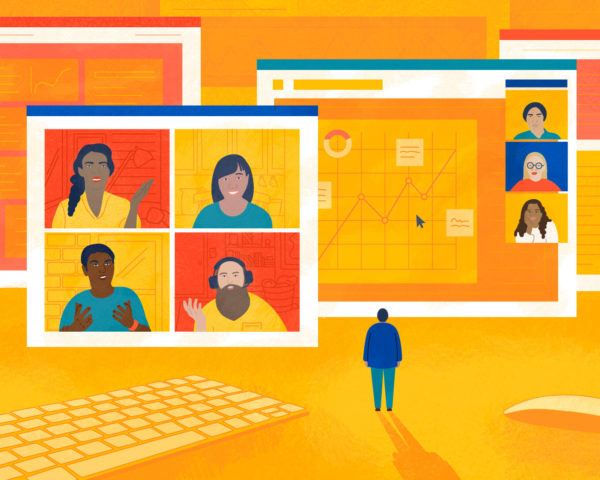Pandemic pivots: lessons from 5 CIOs who had to innovate on the fly
How to ensure your team is ready to respond during a crisis.
The list of unsung heroes of 2020 will be long and varied. Some of those people are obvious: frontline medical workers, grocery clerks, and delivery workers come to mind.
Meanwhile, behind the scenes, the tech industry has been busy – not only meeting increased demand for services – but innovating to solve new problems that have arisen living life under lockdown.
Now that we’re more than eight months into the “now normal,” we wanted to look back and see what we could learn from the early days of the COVID-19 crisis. How did companies pivot to address new complexities? What processes, mindsets, and tools did they use to power through novel challenges that they hadn’t planned for?
Here, in their own words, five CIOs share their takeaways from the COVID-19 crisis. As companies of all sizes consider how to plan for the unexpected, these lessons can help create future roadmaps that enable resilience and adaptability.
Dropbox: put enterprise agility to the test when the world shifted to remote work
“I think of enterprise agility like a rhythm,” Dropbox CIO Sylvie Veilleux explained. “All functions and teams are playing music from the same hymn sheet. You are on the same beat. If one part of your business needs to rapidly respond to an opportunity or a challenge, you can better orchestrate the entire effort.”
This is the philosophy that carried cloud-storage service Dropbox through March and April, when the company saw a 60 percent increase in desktop app users and triple the requests for its e-signature platform HelloSign.
“With the onset of COVID-19, one publishing industry client of ours needed to quickly enable employees to work from home,” Veilleux said. “It was incredibly important to find an industry-adopted solution that enabled them to use best-of-breed tools and integrations to help keep their business functioning. Dropbox was already a known tool at the company, and in the industry as a whole, and by deploying it on a larger scale they were able to get their employees up and running and collaborating seamlessly in just one day.”
Veilleux is now looking ahead and considering what’s next. “We have to continue to change and innovate the way we work,” she said. “While we’ve all been suddenly forced to work in fully distributed teams due to the pandemic, we certainly think there will be lasting effects beyond when we are physically back to work.”
Honeywell: re-evaluated the customer journey while meeting critical need for protective gear
As the first wave of COVID-19 cases began to converge on hospitals last spring, the healthcare community issued an urgent cry for help. Supplies of N95 respirators – the only masks known to prevent transmission of the coronavirus – were critically low. Frontline medical providers were forced to reuse N95 masks or settle for less-effective protection.
Tech and manufacturing giant Honeywell decided to convert two of its production facilities to N95 mask production. The problem was, converting a production line would typically take nine months. Sheila Jordan, chief digital technology officer at Honeywell, had a significant challenge ahead of her. “In an unprecedented emergency like this, we [had] to pivot as quickly as we [could],” Jordan said. “By being agile before the crisis, we had an opportunity to use our facilities, processes, and policies to create products and services that will help the world stay safe and healthy.”
Ultimately, Honeywell was able to convert to mask production in under six weeks. Along the way, the company learned some lasting lessons that can be applied to the changing workplace.
“Everything you do in this digital world comes down to more than just one function. There are multiple functions that have to come together and address a particular experience holistically,” said Jordan. “We have a lot of AI in our products and services that we’re continuing to adjust as we all determine what returning to the office really means. We have a definite role to play in terms of how we can make that happen in a safe and secure way.”
Jordan continued, “In the customer or employee journey, you need to understand where you might have some friction. A digital customer journey only comes together when you understand how the processes fit together horizontally across many functions. The opportunity is when you can stitch those processes together as you continue to make improvements. You can’t really do a whole lot until you understand how they could ultimately fit together to help make these customer and employee interactions much more productive.”
Medecision: adopted a holistic approach to agile to deliver ready-made solutions for virtual healthcare
How could at-risk populations get the continuing medical care they needed under quarantine conditions? This was a challenge that Medecision, an integrated health management solutions company, was poised to meet.
“Our virtual health engagement offerings have been under development for years, but adoption had been slow. People had muscle memory about walking into urgent care facilities or their primary care provider’s office,” explained Rick Koloski, group senior vice president of engineering and architecture at Medecision. “With COVID-19, the barrier to adoption has been removed, and our solutions are being used in new and innovative ways. In a positive sense, it’s been game-changing for how people receive healthcare.”
“In the same way that a technology company might utilize various collaborative and workflow solutions, [our solution] Aerial helps our clients manage the interactions involved in care delivery,” Koloski said. “As a care manager, you can see not only upcoming appointments, but also video and text interactions in a unified way. That’s the same thing in terms of our implementation of enterprise agility.”
Koloski added, “At the enterprise scale, bringing agile thinking should include product engineering, finance and a number of other disciplines. Informing those areas and making the whole enterprise resilient to the new pace of change means going from the canonically popular model of agile software development to true enterprise agility.”
ACI: took a global view to allow individuals and businesses access their money faster
The economic impact of the pandemic came into sharp focus early last spring. “Faster access to funds for individuals and small businesses [had] never been more critical,” said Mitesh Mehta, SVP of IT at ACI Worldwide.
Payment systems company ACI, which handles over 500 million bill pay transactions a year, quickly realized the need to enhance its contact-less digital payment offerings. “The need for digital communication methods, payment deferrals, and payment plans is imperative in helping our customers better serve their consumers financially impacted by the pandemic,” Mehta said. “The solutions also help billers better manage call center volumes through new digital automation touch points like smartphones and mobile wallets.”
Mehta added, “Primarily, this centers around the idea of transacting remotely – between people or between people and systems. Processes and transactions that had remained stubbornly non-digitized despite the tremendous technology innovation in the past 25 years have become targets of digitization overnight. Simple transactions like signing documents to major enterprise deals are beginning to be executed remotely without a single handshake.”
“Disaster recovery, failover, and resiliency are now table stakes. The ability to stay operational through local or worldwide crises is no longer a nice-to-have reserved for the largest corporations,” Mehta said. “The right technologies implemented by industry experts bringing standardized global best practices to bear can be truly transformational.”
NTT: prioritized precision over speed to boost customers’ ability to respond
With a presence in 57 countries and 6,000 clients around the world, telecommunications carrier NTT is accustomed to supporting businesses with their IT operations and infrastructure needs under a wide variety of conditions and settings. But COVID-19 added an entirely new layer of complexity.
“It’s not just about speed,” said John Andrews, NTT’s SVP of service offer design and development. “It’s about how we respond to market forces, competitive actions and advances in technology. It’s being able to pivot, persevere, or stop at the right time and with minimum delay. This is where true agility comes into force, and it’s a crucial survival practice for any organization.
“COVID-19 has actually sharpened the meaning and relevance of enterprise agility, along with the actions that could be regarded as driving it,” Andrews said. “Being able to stand up services for our clients and enable them to maintain their operations has been an absolute imperative for us. We have seen a dramatic increase in the adoption of enterprise agility in processes and operations, and this is accelerating digital transformations in ways that we did not foresee.
“Our ambition is that we’ll all come out of this crisis stronger. We’ll come out of it more agile and more together than ever before,” Andrews said. “We reimagine what’s possible, we rebound – and we thrive.”













































